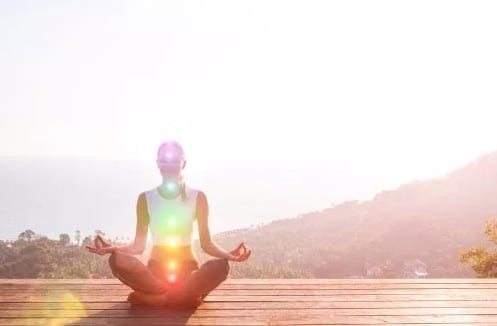Chakras is another Eastern concept becoming increasingly popular in the Western world but why all the hype? Read on to learn more on what Chakras are and why they matter! What Are Your Chakras And Why You Should Care.
In Eastern traditions, time is viewed as cyclical, the universe is governed by energy forces and all elements of life are interconnected. It’s no surprise then that these principles are also applied to body which is believed to be composed of energy forces better known as Chakras.
What’s A Chakra?
A Sanskrit word, Chakra can be translated to mean “wheel” with an origin linked to Hinduism from the times of Ancient India. Though Eastern traditions may vary on the amount of Chakras in the body (for example some Buddhist texts site five while Hinduism generally sites seven. For the purpose of this piece, we will refer to the seven Chakras), they are generally accepted as individual spinning wheels of energy located throughout the body that are all connected through a complex network almost like a spiritual nervous system.
Why Pay Attention To Our Chakras?
Even Western Medicine is beginning to understand one of the deeply rooted beliefs in Eastern Medicine which is the importance of the mind-body-spirit connection. The circulating wheels of energy represented by the Chakras are not only believed to be associated to the functioning of major organs and nerves but also our emotional, psychological and spiritual states of well-being. With this philosophy in mind, a key to good health is ensuring all the Chakras are open and aligned so that our energy life force (Prana in Sanskrit) can flow freely throughout our body. That being said, when/if/should one of our Chakras get blocked (for example through emotional trauma), it’s believed it can lead to an imbalance in our body which can impact our health (both mental and physical).

Where Is Each Chakra In The Body And What Does It Represent?
A complex, interesting system, the first step is an awareness that one of your Chakras may be imbalanced (yoga and meditation are often a suggested practices for restoration). To support your first step, read our light overview on each Chakra below with the Sanskrit version in parenthesis:
Root Chakra (Muladhara):
- Location: at the base (or the root) of the spine in the tailbone area.
- Represents: Feelings of being grounded (or rooted) and/or our foundation.
- Emotional challenges: When blocked, we may feel unstable in areas of basic survival needs such as shelter, finances and/or independence.
- Body parts it’s linked to: the kidneys, spinal column, legs and colon.
- Color Association: Red.
- Mantra Association: “I am” (“VAM” in Sanskrit).
Sacral Chakra (Svadhisthana):
- Location: At the sacrum, the large bone at the base of the spine.
- Represents: Feelings of being emotionally balanced, pleasure and sexuality.
- Emotional challenges: When blocked, we may feel a lack of abundance, well-being and/or pleasure.
- Body parts it’s linked to: Bladder, reproductive organs and prostate.
- Color Association: Orange.
- Mantra Association: “I feel” (“LAM” in Sanskrit).
Solar Plexus Chakra (Manipura):
- Location: At the abdomen just above the navel.
- Represents: Feelings around self-love including worth, control over our life, confidence and will-power.
- Emotional challenges: When blocked, we may feel a lack of self-worth and/or confidence.
- Body parts it’s linked to: Digestion including pancreas, liver and stomach.
- Color Association: Yellow.
- Mantra Association: “I do” (“RAM” in Sanskrit).
Heart Chakra (Anahata):
- Location: At the center of the chest just above the heart.
- Represents: Feelings around our ability to love (both giving and receiving), passion and devotion.
- Emotional challenges: When blocked, we may feel a lack of love, acceptance, inner-peace and/or joy.
- Body parts it’s linked to: Circulatory system, the heart, arms and hands.
- Color Association: Green.
- Mantra Association: “I love” (“YAM” in Sanskrit).

Throat Chakra (Vishuddha):
- Location: At the throat by the thyroid gland.
- Represents: Feelings around our ability to communicate, honesty, security and creativity.
- Emotional challenges: When blocked, we may feel unable to explain and/or express our thoughts.
- Body parts it’s linked to: Thyroid, throat, mouth and hypothalamus.
- Color Association: Blue.
- Mantra Association: “I speak” (“HAM” in Sanskrit).
Third Eye Chakra (Ajna):
- Location: At the middle of both eyes on the forehead (the center of the brain).
- Represents: Feelings around our ability to focus, clearly tap into our intuition, wisdom and imagination.
- Emotional challenges: When blocked, we may struggle with decisions and seeing the bigger picture.
- Body parts it’s linked to: Nose, ears, pituitary and pineal glands.
- Color Association: Deep purple.
- Mantra Association: “I see” (“OM” in Sanskrit).
Crown Chakra (Sahasrara):
- Location: At or just above the crown of the head.
- Represents: Feelings around bliss, awareness and being spiritually connected to a higher consciousness.
- Emotional challenges: When blocked, we may feel spiritually disconnected from inner and outer beauty.
- Body parts it’s linked to: No direct organs associated with it but it is linked to the upper brain.
- Color Association: Multi-colored or light-purple or white.
- Mantra Association: “I understand” (“HA”in Sanskrit but “OM” is also used).
By recognizing and understanding each Chakra, you can mindfully take a closer look at them and see how it fits in your overall physical and spiritual being.
Main Image Photo Credit: https://blog.mindvalley.com
Rachna Sethi
Author
Rachna (@thesassyspiritual) is a graduate of the Applied Mindfulness Meditation program from the University of Toronto, a certified Educator with two bachelor degrees and a diploma in Art Therapy. She's dedicated to living with a compassionate approach. Committed to helping people integrate Mindfuln...














































































































